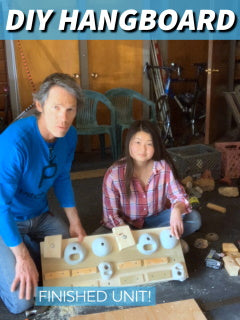Toes to Knows Climbing Academy

Academy: Isometric Planks
In the Lyti training summer series, Lyti struggles with doing regular pushups, making it hard to progress the exercise for her. One alternative exercise that works pretty well is an...
Academy: Isometric Planks
In the Lyti training summer series, Lyti struggles with doing regular pushups, making it hard to progress the exercise for her. One alternative exercise that works pretty well is an...

Academy: Lyti's Training Plan
Part of our "Toes to Knows" Climbing Academy series--covering climbing from footwork to mental preparation. Tags: Coaching, Hangboarding, Advanced, Intermediate, Training In this post, we go over a training protocol...
Academy: Lyti's Training Plan
Part of our "Toes to Knows" Climbing Academy series--covering climbing from footwork to mental preparation. Tags: Coaching, Hangboarding, Advanced, Intermediate, Training In this post, we go over a training protocol...

Academy: Hangboarding Cycles
See how to combine climbing max hang and strength-endurance repeaters into a larger training macrocycle. We give an example for optimal route sending potential in the spring and fall.
Academy: Hangboarding Cycles
See how to combine climbing max hang and strength-endurance repeaters into a larger training macrocycle. We give an example for optimal route sending potential in the spring and fall.

Academy: Two-Arm Max Hangs
This week, I’m going to go over max hangs again, but this time with two arms. Two-arm vs. one-arm max hangs are pretty similar, with other than the obvious difference...
Academy: Two-Arm Max Hangs
This week, I’m going to go over max hangs again, but this time with two arms. Two-arm vs. one-arm max hangs are pretty similar, with other than the obvious difference...

Academy: Single-Arm Max Hangs
Max Hangs are a great way to gain climbing strength quickly. If you're stuck at home without the equipment for two-handed max hangs, then one-hand versions are a great alternative....
Academy: Single-Arm Max Hangs
Max Hangs are a great way to gain climbing strength quickly. If you're stuck at home without the equipment for two-handed max hangs, then one-hand versions are a great alternative....

Academy: Build Your Own Hangboard
If hangboards feel a bit too expensive to you, or if, because of a global pandemic, you can’t find one in stock, you can easily build your own hangboard at...
Academy: Build Your Own Hangboard
If hangboards feel a bit too expensive to you, or if, because of a global pandemic, you can’t find one in stock, you can easily build your own hangboard at...
